Legged Robots That Balance
�
The MIT Press Series in Artificial Intelligence
Edited by Patrick Henry Winston and Michael Brady
Artificial Intelligence: An MIT Perspective, Volume I: Expert Problem
Solving, Natural Language Understanding, Intelligent Computer Coaches,
Representation and Learning edited by Patrick Henry Winston and
Richard Henry Brown, 1979
AritiHcial Intelligence: An MIT Perspective, Volume II: Understanding
Vision, Manipulation, Computer Design, Symbol Manipulation edited by
Patrick Henry Winston and Richard Henry Brown, 1979
NETL: A System for Representing and Using Real- World Knowledge by Scott
Fahlman, 1979
The Interpretation of Visual Motion by Shimon Ullman, 1979
A Theory of Syntactic Recognition for Natural Language by Mitchell P.
Marcus, 1980
Turtle Geometry: The Computer as a Medium for Exploring Mathematics by
Harold Abelson and Andrea diSessa, 1981
From Images to Surfaces: A Computational Study of the Human Early Visual .
System by William Eric Leifur Grimson, 1981
Robot Manipulators: Mathematics, Programming and Control by Richard P.
Paul, 1981
Computational Models of Discourse edited by Michael Brady and Robert C.
Berwick, 1982
Robot Motion: Planning and Control by Michael Brady, John M. Hollerbach,
Timothy Johnson, Tomas Lozano-Perez, and Matthew T. Mason, 1982
In-Depth Understanding: A Computer Model of Integrated Processing for
Narrative Comprehension by Michael G. Dyer, 1983
Robotics Research: The First International Symposium edited by Michael
Brady and Richard Paul, 1984
Robotics Research: The Second International Symposium edited by Hideo
Hanafusa and Hirochika Inoue, 1985
Robot Hands and the Mechanics of Manipulation by Matthew T. Mason and
J. Kenneth Salisbury, Jr., 1985
The Acquisition of Syntactic Knowledge by Robert C. Berwick, 1985
The Connection Machine by W. Daniel Hillis, 1985
Legged Robots that Balance by Marc H. Raibert, 1986
Legged Robots That Balance
Marc H. Raibert
The MIT Press
Cambridge, Massachusetts
London, England
�
All rights reserved. No part of this book may be reproduced in any form
by any electronic or mechanical means (including photocopying, recording,
or information storage and retrieval) without permission in writing from
the author.
To Ivan Sutherland
Library of Congress Cataloging-in-Publication Data
Raibert, Marc H.
Legged robots that balance.
(The MIT Press series in artificial intelligence)
Bibliography: p.
Includes index.
1. Robotics. 2. Artificial intelligence. I. Title.
II. Series.
TJ211.R35 1986
ISBN 0-262-18117-7
629.8'92
85-23888
The MIT Press, Cambridge, Massachusetts
Copyright © 1986 by Marc H. Raibert
All rights reserved. Published 1986
Printed in the United States of America
�
Contents
Series Foreword
Preface
Chapter 1. Introduction
Why Study Legged Machines?
Dynamics and Balance Improve Mobility
Research on Legged Machines
Research on Active Balance
Introduction to Running Machines
Additional Readings
. .
. .
.
.
Chapter' 2. Hopping on One Leg in the Plane
A Planar Machine That Hops on One Leg
. .
Control of Running Decomposed into Three Parts
Hopping Experiments
.
Improvements and Limitations
Summary
. .
. .
. .
.
.
.
.
.
.
.
Chapter 3. Hopping in Three Dimensions
Balance in Three Dimensions
.
.
3D One-Legged Hopping Machine
Control System for 3D One-Legged Machine
. . . .
.
. .
.
Xl
Xlll
1
1
4
6
11
14
26
29
30
37
48
52
55
57
58
62
67
�
vm
Chapter
. . . .
Hopping Experiments in Three Dimensions
Summary . . . . . . . . . . . . . . . . . . .
Appendix 3A. Kinematics of 3D One-Legged Machine
Chapter 4. Biped and Quadruped Running
. . . . . . . . . .
. . . . . . . . . . . .
. . . . . .
One-Foot Gaits
Virtual Legs
. . . .
.
Quadruped Trotting Experiments Using Virtual Legs
Discussion of Quadruped Experiments
Summary . . . . . . . . . . . .
Appendix 4A. Equations for Virtual Leg
Appendix 4B. Kinematics for Four-Legged Machine
Chapter 5. Symmetry in Running
Mechanics of Symmetry
. . .
Symmetry in Animal Running
Scissor Symmetry
. . . . .
What Does Symmetry Mean?
Summary
Appendix 5A. Equations of Motion for Planar Systems
Appendix 5B. Proof of Symmetric Leg Motion
. . . . . . . . .
. . . .
Contents
ix
Chapter 8. Research on Animals and Vehicles
Experiments in Animal Locomotion
The Development of Useful Legged Robots
Running Is Like Juggling
. . . . . . .
Do Locomotion and Manipulation Have a Common Ground?
Bibliography
Index
189
189
196
198
200
203
229
71
78
80
83
84
92
96
102
105
107
109
115
117
124
130
134
136
138
140
Chapter 6. Alternatives for Locomotion Control
143
. . .
More on the Control of Bouncing
143
An Alternative Three-Part Control
. . .
154
Taxonomy of Control for Quadruped Running
160
Summary
. . .
170
Appendix 6A. Equations of Motion for Planar One-Legged Model 171
. . . . . . . . . . . . .
. . .
. .
Chapter 7. Tabular Control of Running
Background on the Use of Tables for Control
A Tabular Method for Control
. .
Polynomial Approximations to Tabular Data
Conclusions
. .
Appendix 7 A. Performance Index Minimization for Table
Appendix 7B. Performance Index Minimization for Polynomial
. . . . . . . . . .
. . . .
. .
173
173
176
180
184
186
187
�
SERIES FOREWORD
Artificial intelligence is the study of intelligence using the ideas and meth
ods of computation. Unfortunately, a definition of intelligence seems im
possible at the moment because intelligence appears to be an amalgam of
so many information-processing and information-representation abilities.
Of course psychology, philosophy, linguistics, and related disciplines
offer various perspectives and methodologies for studying intelligence. For
the most part, however, the theories proposed in these fields are too in
complete and too vaguely stated to be realized in computational terms.
Something more is needed, even though valuable ideas, relationships, and
constraints can be gleaned from traditional studies of what are, after all,
impressive existence proofs that intelligence is in fact possible.
Artificial intelligence offers a new perspective and a new methodology.
Its central goal is to make computers intelligent, both to make them more
useful and to understand the principles that make intelligence possible.
That intelligent computers will be extremely useful is obvious. The more
profound point is that artificial intelligence aims to understand intelligence
using the ideas and methods of computation, thus offering a radically new
and different basis for theory formation. Most of the people doing arti
ficial intelligence believe that these theories will apply to any intelligent
information processor, whether biological or solid state.
There are side effects that deserve attention, too. Any program that
will successfully model even a small part of intelligence will be inherently
massive and complex. Consequently, artificial intelligence continually con
fronts the limits of computer science technology. The problems encountered
have been hard enough and interesting enough to seduce artificial intelli
gence people into working on them with enthusiasm. It is natural, then,
that there has been a steady flow of ideas from artificial intelligence to
computer science, and the flow shows no sign of abating.
The purpose of this MIT Press Series in Artificial Intelligence is to
provide people in many areas, both professionals and students, with timely,
detailed information about what is happening on the frontiers in research
centers all over the world.
Patrick Henry Winston
Michael Brady
Preface
I first became interested in legged locomotion in 1974 when I was a graduate
student at MIT. Berthold Horn and Mitch Weiss had been thinking about
legs being like the spokes of a wheel, so they took the rim off of a spoked
wheel and rolled it down a ramp to see what it would do. It didn't do very
much, but it got me thinking about legs and legged locomotion.
One problem with the rimless wheel was that the spokes were too stiff,
so they did not stay on the floor long enough to give the hub a chance to
turn. I had learned from Emilio Bizzi that the springy characteristics of
muscle and tendon played an important role in controlling animal limb
movement, and it seemed to me that the spokes would work better if they
were somewhat springy too. Another problem with the rimless wheel was
the lack of a means for keeping it upright, so it fell over after one or two
steps-it needed a mechanism for balance.
It was not until 1979 that I had an opportunity to pursue the subject
further. I was teaching a robotics course as a visitor at Caltech when Ivan
Sutherland encouraged me to start a robotics project in his department. I
mentioned to him that a computer controlled pogostick would be a good
model for learning about control and balance, and that it might lead to a
fundamental understanding of legged locomotion. To my astonishment he
took the idea seriously. With money from one of Sutherland's slush funds
and substantial help from Elmer Szombathy in the machine shop, I built
a preliminary machine that was to hop and balance like a pogostick on a
single springy leg (see photograph).
From the moment Sutherland and I showed the machine to Craig Fields
in 1980-we had carried it to Washington in an old suitcase-it took less
than a month for the Defense Advanced Research Projects Agency to sup
port the project and to initiate a national research program on legged
vehicles. In 1981 I relocated to Pittsburgh and established the Leg Lab
oratory at Carnegie-Mellon University where my colleagues and I finished
the preliminary machine and went on to build several others. This book
�
Pref ace
xin
They have made this work possible through their support, and the support
of their institutions, the Defense Advanced Research Projects Agency and
the System Development Foundation.
Many colleagues and students have helped by reading all or parts of the
manuscript. They include: Ben Brown, Nancy Cornelius, Matt Mason, Ken
Goldberg, Ivan Sutherland, and especially Michael Chepponis and Jessica
Hodgins. Ivor Durham's PLOT program generated the graphs used in the
text. Ivor made several additions and changes to PLOT specifically for this
book, for which I am particularly grateful. The technical illustrations were
drawn by Steve Talkington. Michael Ullner wrote the typesetting macros
and Roberto Minio helped with the formatting. Sylvia Brahm contributed
in many ways.
Finally, I must thank my family, Nancy, Matthew, and Linda, for their
loving support throughout this project.
Pittsburgh, Pennsylvania
October 1985
M.H.R.
xii
Preface
An early one-legged hopping machine (right) as shown to Craig Fields, together with a
competitor. This picture was taken in the Spring of 1981 when neither legged system
was yet operational.
is about those machines and the progress we have made in using them to
understand the fascinating problem of legged locomotion.
Unfortunately, the behavior of a dynamic legged system is difficult to
convey through the printed word and still photograph. To compensate for
this limitation, I have compiled a videotape that forms an appendix to this
book. It includes material from the running machines described in the text
and from several of the computer simulations. The tape runs about fifteen
minutes and copies are available from the MIT Press.
It is not possible to thank individually all those who have contributed
to this book and to the work it reports. I am particularly grateful to the
members of the Leg Laboratory who have made contributions of all sorts,
especially Ben Brown and Michael Chepponis.
Ivan Sutherland helped
get this research started and continues to be a rich source of inspiration
and good ideas. Stimulating and provocative discussions with Matt Mason
cleared up several technical issues.
I am indebted to Craig Fields, Clint Kelly, and Charlie Smith who
let the idea of a legged technology capture their imaginations and vision.
�
Legged Robots That Balance
�

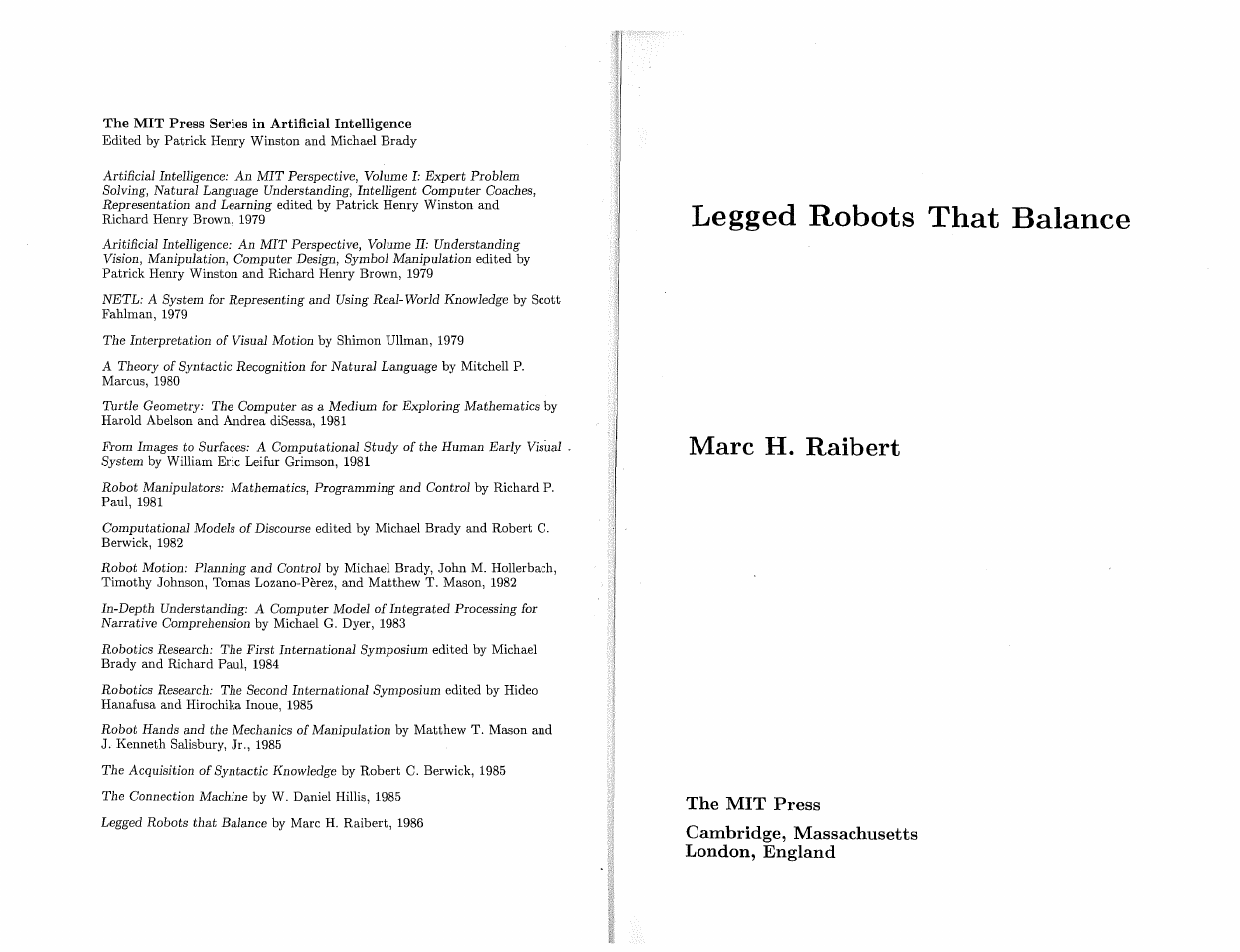
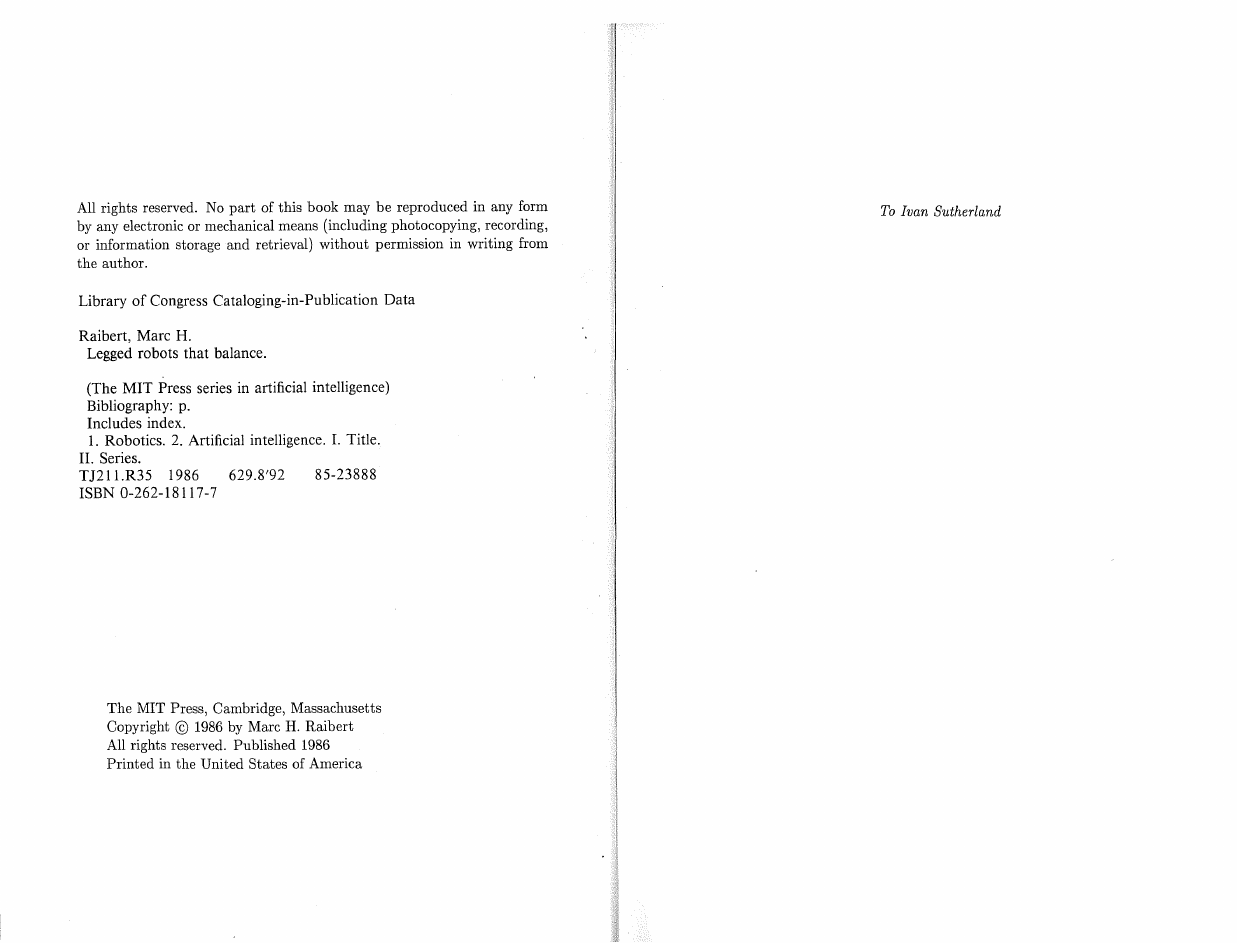
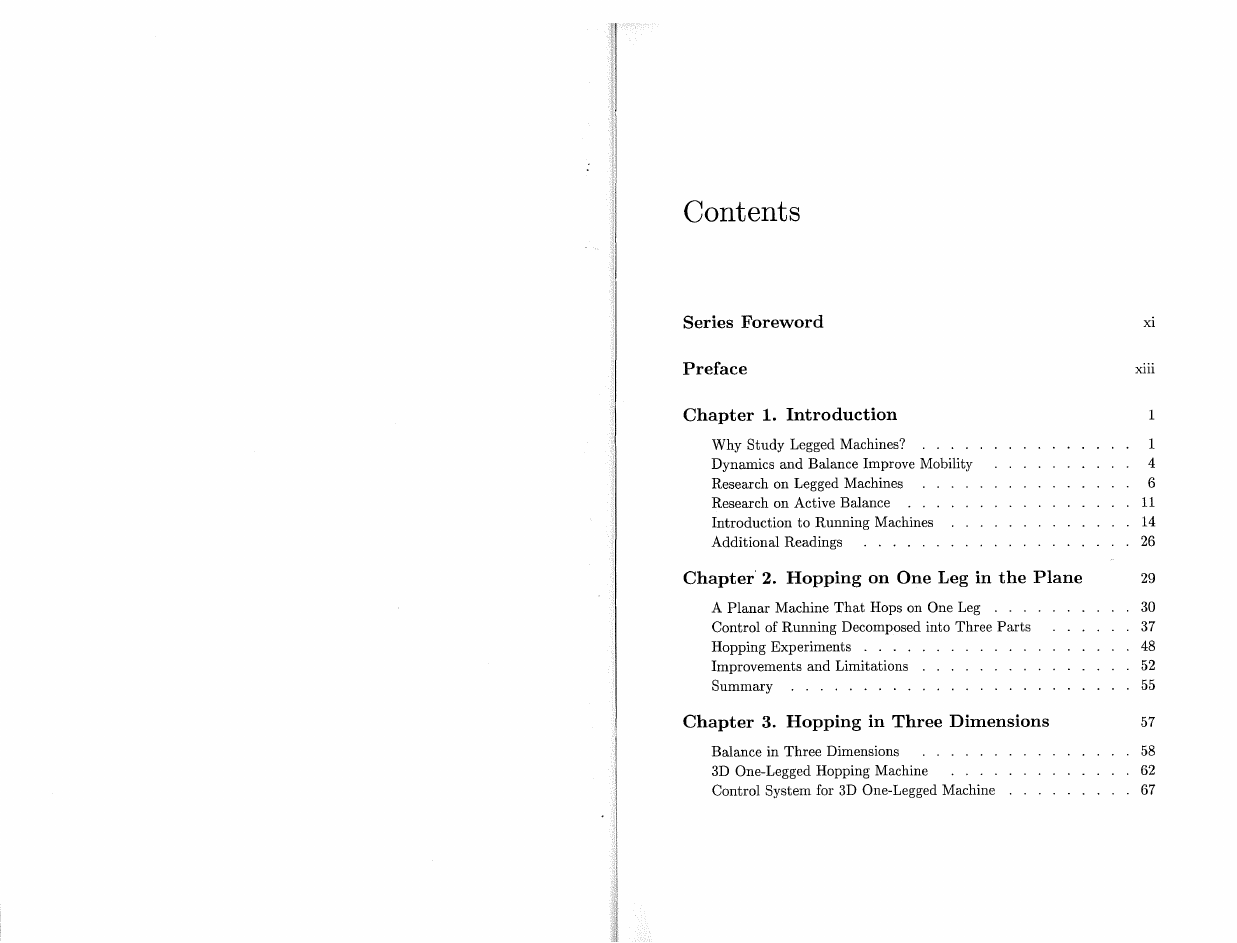
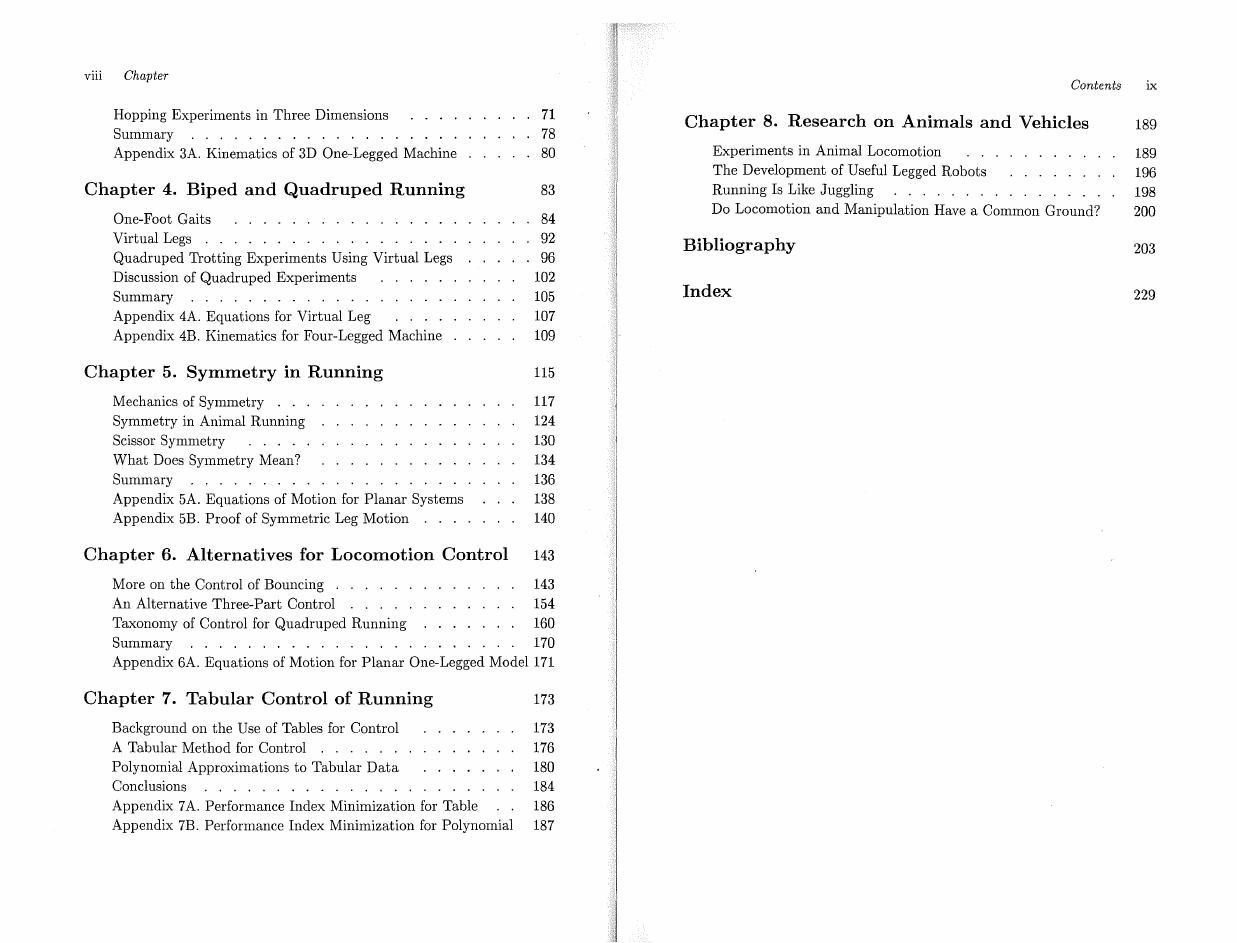
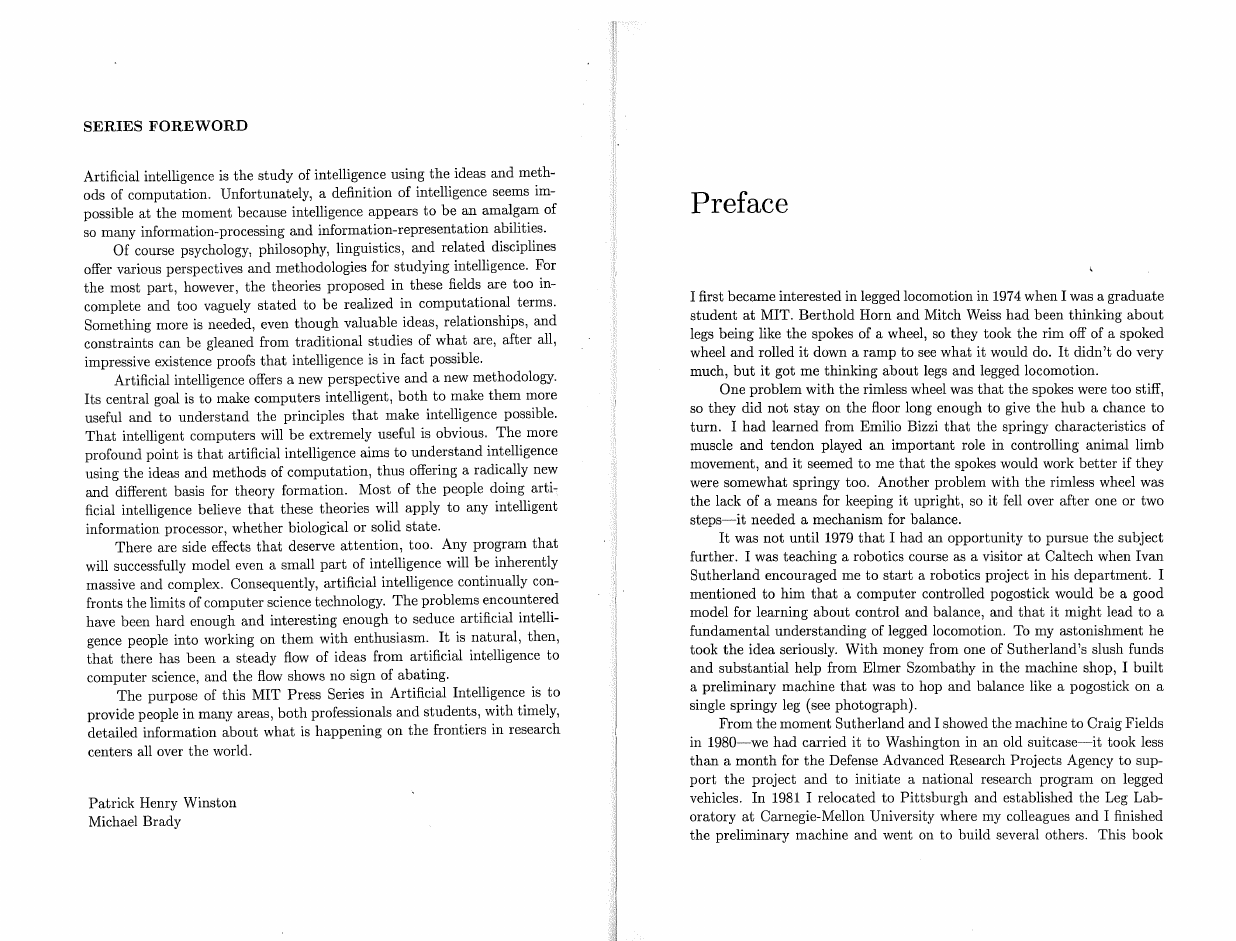
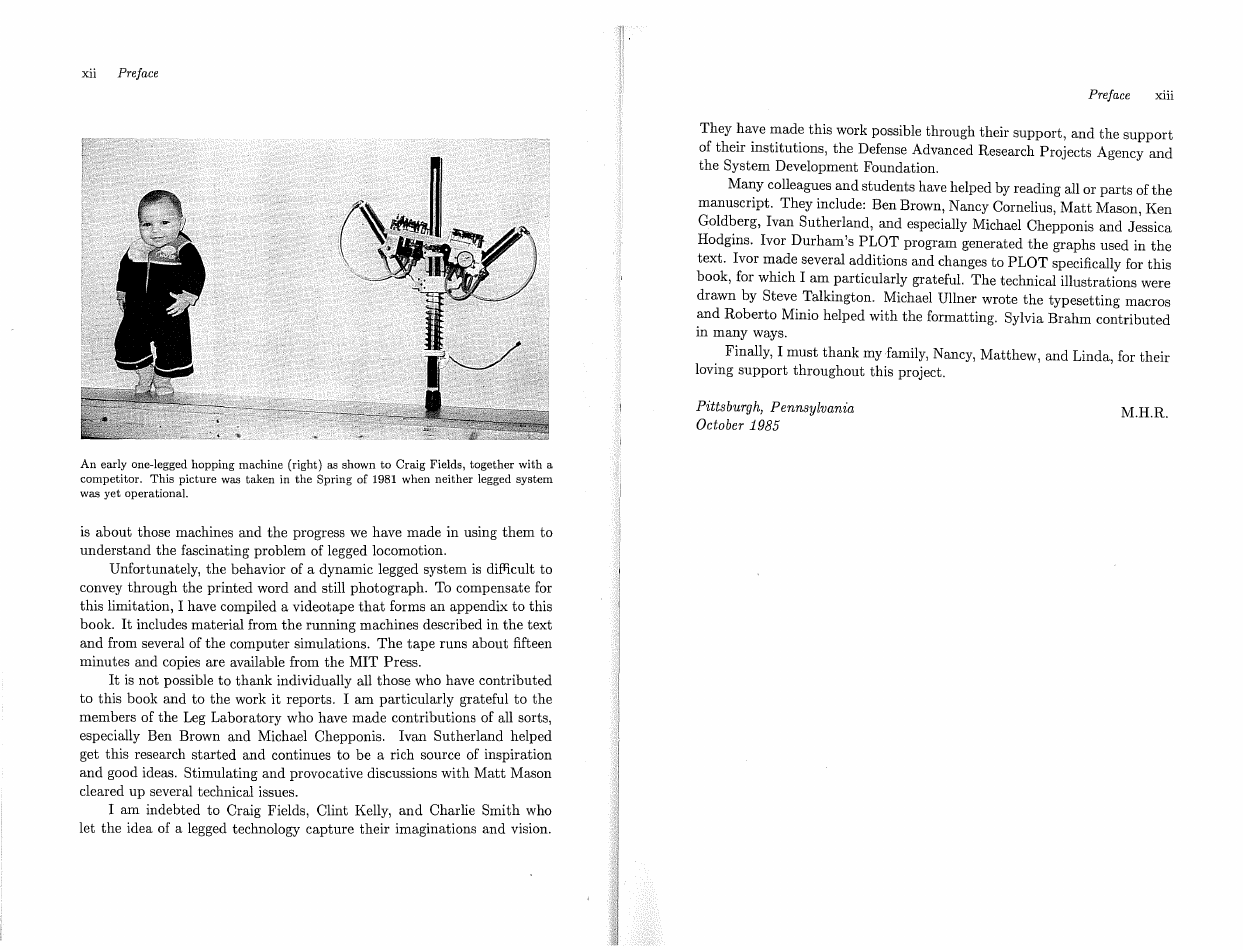
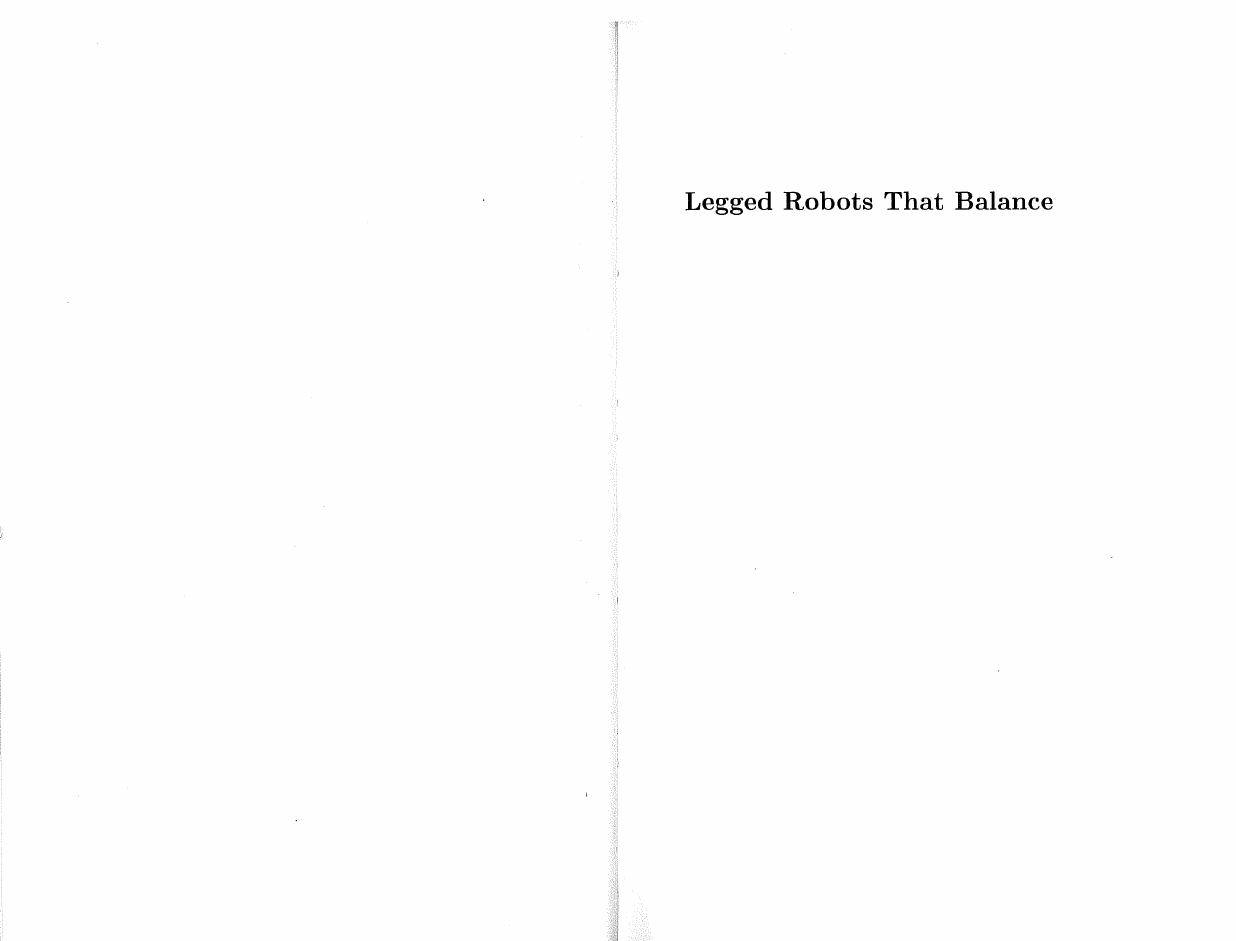








 2023年江西萍乡中考道德与法治真题及答案.doc
2023年江西萍乡中考道德与法治真题及答案.doc 2012年重庆南川中考生物真题及答案.doc
2012年重庆南川中考生物真题及答案.doc 2013年江西师范大学地理学综合及文艺理论基础考研真题.doc
2013年江西师范大学地理学综合及文艺理论基础考研真题.doc 2020年四川甘孜小升初语文真题及答案I卷.doc
2020年四川甘孜小升初语文真题及答案I卷.doc 2020年注册岩土工程师专业基础考试真题及答案.doc
2020年注册岩土工程师专业基础考试真题及答案.doc 2023-2024学年福建省厦门市九年级上学期数学月考试题及答案.doc
2023-2024学年福建省厦门市九年级上学期数学月考试题及答案.doc 2021-2022学年辽宁省沈阳市大东区九年级上学期语文期末试题及答案.doc
2021-2022学年辽宁省沈阳市大东区九年级上学期语文期末试题及答案.doc 2022-2023学年北京东城区初三第一学期物理期末试卷及答案.doc
2022-2023学年北京东城区初三第一学期物理期末试卷及答案.doc 2018上半年江西教师资格初中地理学科知识与教学能力真题及答案.doc
2018上半年江西教师资格初中地理学科知识与教学能力真题及答案.doc 2012年河北国家公务员申论考试真题及答案-省级.doc
2012年河北国家公务员申论考试真题及答案-省级.doc 2020-2021学年江苏省扬州市江都区邵樊片九年级上学期数学第一次质量检测试题及答案.doc
2020-2021学年江苏省扬州市江都区邵樊片九年级上学期数学第一次质量检测试题及答案.doc 2022下半年黑龙江教师资格证中学综合素质真题及答案.doc
2022下半年黑龙江教师资格证中学综合素质真题及答案.doc